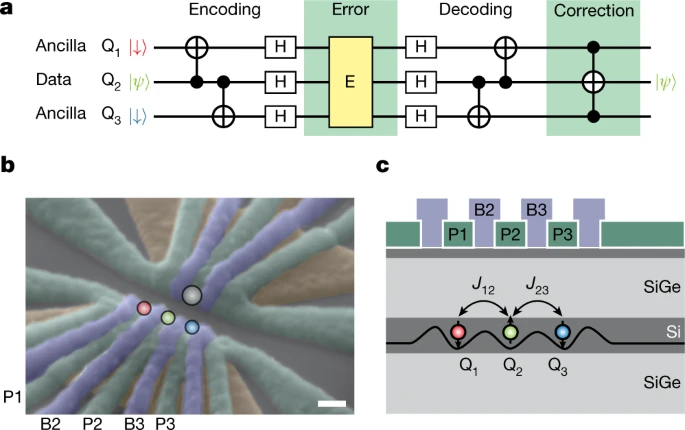Researchers have announced the results of their experiment to show that a one-qubit phase-flip error could be corrected, and the intrinsic ensemble spin dephasing could be mitigated in Silicon. The intrinsic phase error in silicon spin qubits is more like a quasi-static phase shift than a rapid phase flip but in their device, shifting spins of nearby 29Si nuclei create the phase shift. The researchers measure the dephasing of the encoded three-qubit state to illustrate the efficiency of the error-correcting code against this form of phase error.
Quantum computing uses quantum superposition and entanglement to speed up computations. Due to energy relaxation and dephasing, these quantum qualities are susceptible to decoherence errors. The accuracy of computing outcomes decreases exponentially as the number of qubits and/or the complexity of the computational task rises.
The QEC protocol works around this challenge by dispersing the quantum data over a larger multiqubit entangled state, allowing errors to be detected and corrected. Its fundamental idea has been demonstrated on several platforms, including superconducting circuits and nuclear magnetic resonance trapped ions, and it has been used as a crucial benchmark for qubit systems.
Among the potential platforms for developing quantum computing devices, silicon-based spin qubits’ holds promise for overcoming problems in scaling up device sizes from prototypes to large-scale computers since they are compatible with current nanofabrication technologies. Recent improvements in silicon-based qubits have made it possible to create high-quality one-qubit and two-qubit systems.
However, demonstrating QEC, which requires three or more connected qubits1 and a three-qubit gate9-11 or measurement-based feedback, remains a challenge. The most typical method for this adjustment is to projectively measure the ancilla qubits and then use a feedback quantum gate on the data qubit. This method requires monitoring high-fidelity qubits faster than the coherence time, which is currently difficult with spins in silicon. Although this measurement-based operation is critical for fault tolerance, it can also be achieved by a multiqubit conditional qubit rotation in the case of three-qubit QEC.
The researchers used a three-qubit iToffoli gate to implement this strategy. Their sample is a silicon/silicon-germanium (Si/SiGe) heterostructure with a gate-defined triple quantum dot. The sequence starts from encoding the data qubit state to a three-qubit entangled state and mapping the phase-flip errors to the ancilla qubit states by decoding. A correcting logic gate restores the original data qubit state based on the ancilla qubit states.
To control the confinement of the triple-dot, they utilized three layers of overlapping aluminum gates. A micro-magnet was constructed on top of the aluminum gates to create a gradient in the local magnetic field. The radio-frequency reflectometry method was used to measure the triple-dot charge configuration by measuring the conductance of the neighboring charge sensor quantum dot, while resonant microwave pulses were used to produce single-qubit rotations.
This research showed how to generate multiple three-qubit entangled states, the effective single-step resonantly driven iToffoli gate, and the essential features of three-qubit QEC in silicon. A larger-scale demonstration would need a more adaptable feedback-based correcting rotation.

